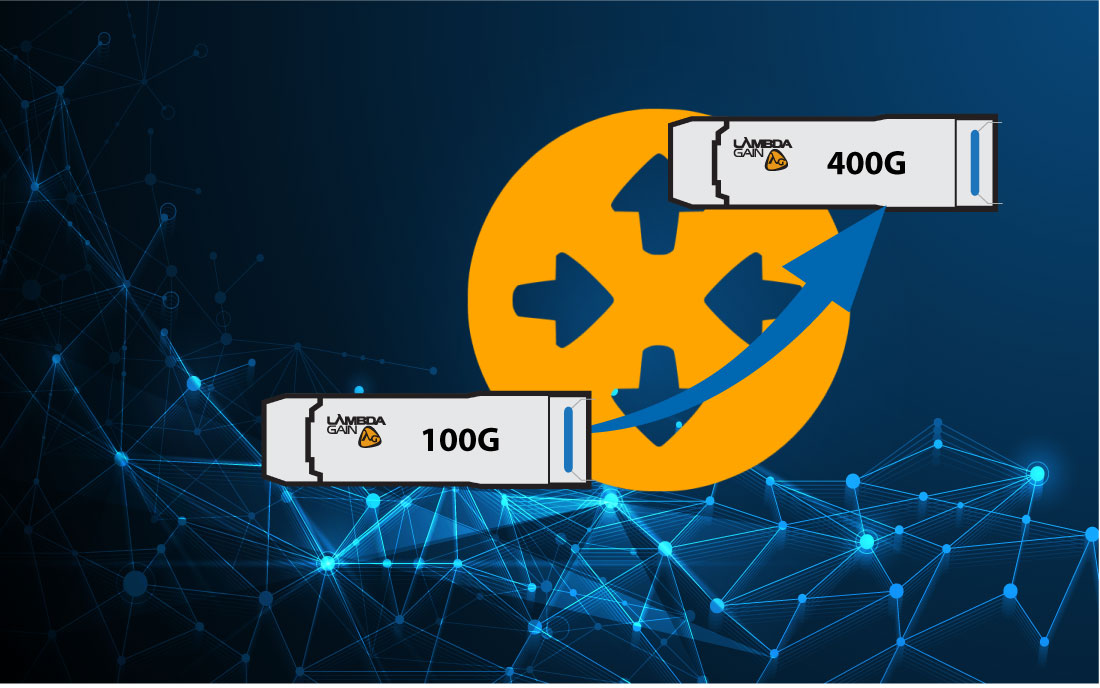
100G-LR Single Wave optics pave the way to 400G
As service providers navigate the shift towards 400G connectivity, the choice of optical solutions becomes critical in facilitating this transition. In this blog, we’ll explore how service providers can leverage 100G-LR single-lambda optics to prepare for a seamless migration to 400G, empowering operators to upgrade sites incrementally at their own pace.
Key Service Provider Use Cases
Service providers can leverage 100G-LR single-lambda optics to address key use cases in their network evolution including:
- Incremental upgrade to 400G hardware: 100G/400G compatibility means that if you operate a network using switches or routers with 100G QSFP28 ports, you can upgrade just the main traffic aggregation site to 400G-equipped pluggable optics, and still connect it to the existing 100G remote sites without sacrificing port bandwidth at the newly upgraded location.
- Future-proofing QSFP28 hardware: 100G-LR single lambda optics deployed today in QSFP28 form factors will be compatible with both 400G-PLR4 QSFP-DD optics and the forthcoming SFP112 SerDes technology.
Smooth Migration to 400G, Incremental Site Upgrades
Single-lambda PAM4 modulation is the common core technology at the heart of both 100G-LR single-lambda Ethernet optics and 400G-PLR4 Ethernet optics, which employ 4 x 100G PAM4 channels to achieve 400G speeds. This enables QSFP-DD 400G pluggable optics to interoperate with single-lambda 100G optics via fiber optic breakout cables.
The compatibility between 100G PAM4 optics and 400G PAM4 optics facilitates a smooth, step-by-step migration from a 100G network to a 400G network. In practice, 100G/400G compatibility means that if you operate a network using switches or routers with 100G QSFP28 ports, you can upgrade just the main traffic aggregation site to 400G pluggable optic, and still connect it to the existing 100G remote sites via a breakout fiber cable configuration without sacrificing port bandwidth at the newly upgraded location. The other sites can be upgraded to 400G over time when required. This step-by-step network upgrade minimizes downtime and allows you to upgrade the other sites when ready or required, which smooths the capex investment over time and increases operational flexibility.

Let’s take a closer look at how an operator can upgrade 2 sites approximately 10km apart and currently operating at 100Gbps to 400Gbps over 3 phases:
Phase 1:
Operator deploys 100G-LR optics on all sites.
Phase 2:
Operator upgrades a main site with 400G capable routers. The operator can install 400G-PLR4 (4 x 100G) optics on the upgraded sites and connect them to 100G-LR legacy sites.
Phase 3:
Eventually the legacy sites can be upgraded to 400G to create 400G connections between sites.
Phase 1:
Operator deploys 100G-LR optics on all sites.
Phase 2:
Operator upgrades a main site with 400G capable routers. The operator can install 400G-PLR4 (4 x 100G) optics on the upgraded sites and connect them to 100G-LR legacy sites.
Phase 3:
Eventually the legacy sites can be upgraded to 400G to create 400G connections between sites.

Forward Compatibility
The adoption of 100G-LR single-lambda optics ensures forward compatibility with future network upgrades. Forthcoming switches and routers will be equipped with 100G SerDes ports, meaning that the FEC and PAM4 functions, which today are implemented in the optical module, will be migrated off-board to an ASIC in the host platform. The potential to move FEC and PAM4 functionality to the host could see new form factors, such as SFP112 play a significant role in the market. However, operators who deploy QSFP28-based 100G optics will benefit from investment protection, as their in-service QSFP28 100G-LR optics will be compatible with SFP112 optics deployed as new hardware is introduced.
LambdaGainTM Solution Elements
QSFP28 100G-LR: Delivering 100Gbps connectivity over 10km with PAM4 modulation, our QSFP28 100G-LR single-lambda transceiver simplifies seamless migration to 400G. Compact, compatible, and future-proof, it sets the foundation for enhanced connectivity.

QSFP-DD 400G-PLR4: Equipped with 4 parallel lanes operating at 100Gbps, each using PAM4 modulation, our QSFP-DD 400G-PLR4 optics seamlessly connect to our QSFP28 100G-LR optics in breakout configurations. These products enable operators to achieve smooth, incremental migration to 400G at their own pace.

Single mode MPO to LC breakout patch cord: To connect a single QSFP-DD 400G-PLR4 optic to 4 x QSFP28 100G-LR optics, operators can use LambdaGain Breakout Cable, OS2 3.0mm Yellow Jacket MPO-12 (Female APC) to 8 LC/UPC. Available in OFNP and LSZH fire ratings and standard polarity options.

Conclusion
100G-LR single-lambda optics offer service providers a flexible and cost-effective solution for migrating to 400G connectivity. By enabling incremental site upgrades and ensuring forward compatibility with future technologies, these optics empower operators to navigate the transition to 400G at their own pace, without sacrificing performance or reliability.
Contact Us
If you are evaluating alternative options in your migration to 400G and would like to know more about how to cost-effectively manage the transition, please contact us.
About FONEX Data Systems inc.
FONEX data systems inc. (FONEX), delivers optimised, purpose-built solutions for wireline and wireless telecommunications service providers across Canada, the USA, and Europe. We combine over 30 years of expertise in telecommunication architectures, standards, and trends with a leading-edge portfolio of carrier-class products to meet and exceed our customers’ business, technical and operational requirements. Find out more about FONEX here.
